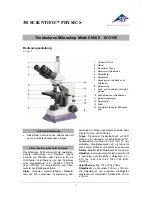
4
STEINDORFF
®
2.2.
Main Features
The S-3000 series microscope is a transmitted-light microscope of compact design with flexibility.
Equipped with 3w/or 5w LED lamp, field diaphragm, Abbe condensers and other optical components,
the standard Köhler illumination system provides uniformly bright and free-from-glare specimen
illumination, which provides a high image quality with brighter and sharper resolutions for
photomicrography. The Compact body is designed for flexibility which can perform various
applications such as brightfield, darkfield and polarization. Trinocular microscope can be equipped with
digital camera and LCD screen for photo and video documentation and image analysis.
The major features of the microscope include:
Ergonomically designed metal frame for stability and durability
Carrying handle integrated in the back of the stand for easy carrying
Arm and base made of one piece construction
Antifungal treatment which prevents fungus growth
Cord holder for convenient storage
Siedentopf eyepiece tubes which will not change the length in the tubes when interpupillary
distance adjustments are made; adjustable interpupillary distance range 4.8cm- 7.5cm
360° head rotation; fully up or down swiveled eyepiece tubes to adjust the viewing height to
meet individual requirements
High eyepoint 10X wide-field focusing eyepieces with 22mm eyepiece field-of-view, suitable
for spectacle wearers and easy to observe.
Diopter adjustment on both eyepieces for the compensation of defective vision, with diopter
scales to facilitate finding the correct setting. Parfocality of focus is assured by independent
diopter adjustment on each eyepiece.
Optional reticule eyepiece for measurement purposes; choice of 0.1mm/1cm grid, 0.1mm/1cm
cross or plain cross hair available (not included)
Revolving reversed quadruple objective nosepiece with DIN objectives which are color-coded,
parcentered, and parfocaled. The nosepiece runs on ball bearings and has internal click stops so
that the image remains centered after each change in magnification.
Finite "Plan-ACHROMAT" DIN objectives with magnifications of 4x, 10x, 40x, and 100x oil.
Retractable 40xR and 100xR objectives equipped with resilient mounts for specimen protection.
Convenient low position coaxial coarse and fine focusing drive (coarse focus knob on left side,
fine focus knob on both sides) with coarse stroke per rotation of 37.7mm and fine focus
0.1mm/circle, fine focus graduation of 1μm; focusing range 16mm; smoothness of coarse
focusing drive being adjustable
21.6cm x 15cm built-in double layer mechanical stage with graphite surface, rounded edges, and
non-extending rack and specimen holder; smooth X/Y calibrated movement with cross travel
range 7.5cm x 5.5cm
Built-in Kohler illumination that uses continuously adjustable LED source with light intensity
control. Light path can be further adjusted by using the field diaphragm.
Full Kohler N.A. 1.25 Abbe condensers which height is controlled by a rack and pinion gear
system that allows the condenser focus to be adjusted for proper illumination of the specimen;
































